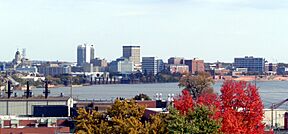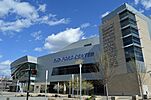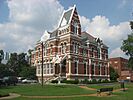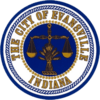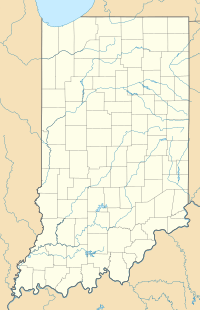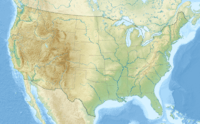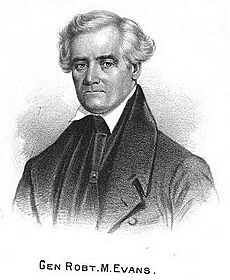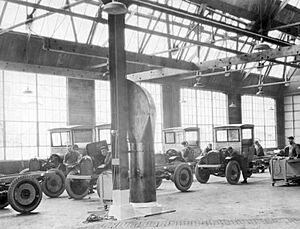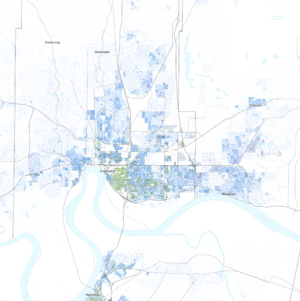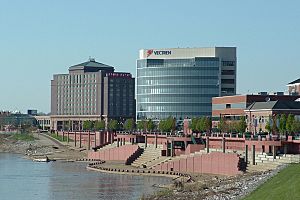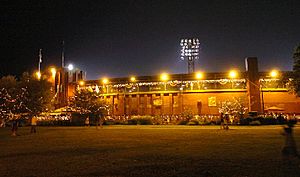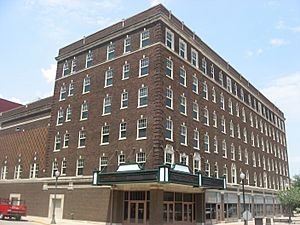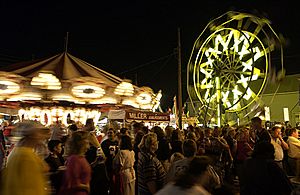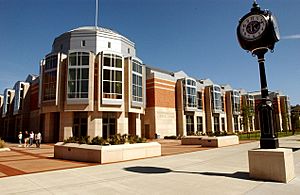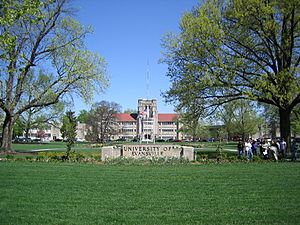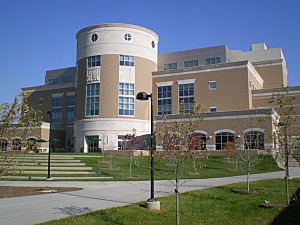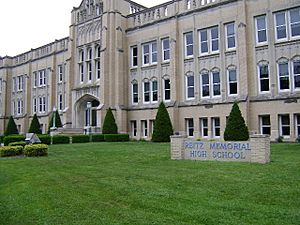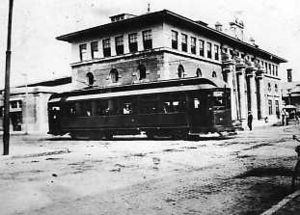Evansville, Indiana facts for kids
Quick facts for kids
Evansville
|
|||
|---|---|---|---|
|
Downtown Evansville skyline from Dreier Boulevard
Ford Center
|
|||
|
|||
| Nicknames:
Eville, The Ville, River City, Stoplight City, Pocket City, Crescent City
|
|||
| Country | United States | ||
| State | Indiana | ||
| Regions | IN–IL–KY Tri-State Area, SW Indiana | ||
| County | Vanderburgh | ||
| Townships | Center, German, Knight, Perry, Pigeon | ||
| Founded | 1812 | ||
| Incorporated | 1817 | ||
| City Charter | 1847 | ||
| Area | |||
| • City | 47.85 sq mi (123.93 km2) | ||
| • Land | 47.35 sq mi (122.65 km2) | ||
| • Water | 0.49 sq mi (1.28 km2) | ||
| • Metro | 2,367 sq mi (6,130 km2) | ||
| Elevation | 384 ft (117 m) | ||
| Population
(2020)
|
|||
| • City | 118,414 | ||
| • Rank | 1st in Vanderburgh County 1st in Southern Indiana 3rd in Indiana 223rd in the United States |
||
| • Density | 2,476.99/sq mi (956.37/km2) | ||
| • Urban | 206,855 (US: 185th) | ||
| • Urban density | 1,834.6/sq mi (708.3/km2) | ||
| • Metro | 358,676 (US: 142nd) | ||
| GDP | |||
| • Metro | $25.278 billion (2022) | ||
| Time zone | UTC−6 (Central (CST)) | ||
| • Summer (DST) | UTC−5 (CDT) | ||
| ZIP codes |
40 total ZIP codes:
47701, 47702, 47703, 47704, 47705, 47706, 47708, 47710, 47711, 47712, 47713, 47714, 47715, 47716, 47719, 47720, 47721, 47722, 47724, 47725, 47726, 47727, 47728, 47730, 47731, 47732, 47733, 47734, 47735, 47736, 47738, 47739, 47740, 47741, 47744, 47747, 47750, 47755, 47761, 47777
|
||
| Area code(s) | 812 & 930 | ||
| FIPS code | 18-22000 | ||
| GNIS feature ID | 434258 | ||
| Demonyms | Evansvillian, Vanderburgh | ||
| Interstate Highways | |||
| U.S. Highways | |||
| Major State Roads | |||
| Waterways | Ohio River, Pigeon Creek | ||
| Airports | Evansville Regional Airport | ||
Evansville is a city in Indiana, United States. It is the county seat of Vanderburgh County, Indiana. With over 118,000 people, it is Indiana's third-largest city. It is also the biggest city in Southern Indiana.
Evansville is a major center for business, medicine, and culture. It serves southwestern Indiana and the nearby areas of Illinois and Kentucky. More than 911,000 people live in this wider region. The city is located on a bend of the Ohio River. This is why it is often called the "Crescent Valley" or "River City." Early French explorers called the river La Belle Rivière, meaning "The Beautiful River."
The area has been home to different Native American groups for thousands of years. Angel Mounds was a large settlement here from about 1000 AD to 1400 AD. The modern city of Evansville was founded in 1812.
Evansville's economy relies on trade, transportation, and services. It also has strong education, healthcare, and manufacturing industries. Several big companies have their main offices in Evansville. These include Berry Global, OneMain Financial, Escalade Sports, Old National Bank, and Shoe Carnival.
The city is home to Bally's Evansville, Indiana's first casino. It also has Mesker Park Zoo and Botanic Garden, one of the state's oldest and largest zoos. Evansville is known for its sports tourism. You can find important schools here too. The University of Evansville is a private school. The University of Southern Indiana is a larger public university nearby. The Indiana University School of Medicine also has a campus in Evansville.
Contents
History of Evansville
Early Days and Native American History
People have lived in the Evansville area since at least 8,000 BC. This was when Paleo-Indians first arrived. Archaeologists have found many ancient sites here. The most important is Angel Mounds. This was a large town built by the Mississippian culture from about 900 AD to 1600 AD.
After Angel Mounds was left around 1400 AD, other Native American tribes lived in the area. These included the Miami, Shawnee, Piankeshaw, Wyandot, and Delaware. French hunters and traders were the first Europeans to visit. They used Vincennes as a base for fur trading. The Delaware tribe gave up the land where Evansville is now in 1805. They gave it to William Henry Harrison, who was then the governor of the Indiana Territory.
How Evansville Was Founded
The city of Evansville was founded in 1812. It officially became a city in 1817. On March 27, 1812, a man named Hugh McGary Jr. bought about 441 acres of land. He called it "McGary's Landing." In 1814, to attract more people, McGary changed the name to "Evansville." He named it after Colonel Robert Morgan Evans.
Evansville became the county seat on January 7, 1818. The county was named Vanderburgh after Henry Vanderburgh. He was a judge in the Indiana Territory. Evansville grew into a busy trading town because of its location on the river.
Growth in the 1800s
Evansville grew a lot in the second half of the 1800s. It was a big stop for steamboats on the Ohio River. Many companies used the river for trade. Coal mining, manufacturing, and wood industries were very important. By 1900, Evansville was one of the world's largest centers for hardwood furniture. It had 41 factories and employed about 2,000 workers.
Railroads became more important than canals. In 1887, the L&N Railroad built a bridge across the Ohio River. This helped Evansville connect to more places. By 1890, Evansville was the 56th largest city in the United States.
Evansville in the 1900s and Today
In the early 1900s, Evansville continued to grow. The Graham brothers started a successful glass factory here. Later, they began making trucks. Their company, Graham Brothers Trucks, was in Evansville until 1929.
The city also worked to improve its transportation. A bridge was built across the Ohio River in 1932. An airport was also developed. However, a big flood in 1937 covered many city blocks. After the flood, higher levees (walls) were built to protect the city from the river.
During World War II, Evansville became a major industrial center. Factories made war supplies, which helped the economy. A huge shipyard built LSTs (landing ships for tanks). The Evansville Shipyard was the largest inland producer of LSTs in the country. A factory near the airport made P-47 Thunderbolt fighter planes. Evansville produced almost half of all P-47s made during the war.
After the war, Evansville's factories continued to do well. They made cars, home appliances, and farm equipment. But in the late 1950s and early 1960s, some factories closed. Luckily, 28 new businesses moved to the area. These included Whirlpool, Alcoa, and General Electric.
In the late 1900s, Evansville became a hub for healthcare and services. The growth of the University of Southern Indiana helped the economy. Big manufacturing plants like Toyota and AK Steel also came to the area. Casino Aztar (now Bally's), Indiana's first gaming boat, also boosted jobs. Today, Evansville continues to have a strong and varied economy.
In 2022, Evansville was named Indiana's American World War II Heritage City. This was to honor its huge efforts during the war.
Geography and Landscape
The Evansville area includes counties in Indiana, Kentucky, and Illinois. This region is often called the "tri-state area." The city itself covers about 44 square miles. Most of it is land, with a small amount of water.
City's Natural Features
The city's southern edge is on a bend of the Ohio River. Most of Evansville is in a shallow valley. It is surrounded by low, rolling hills. The west side of the city is built on these hills. Here you can find Burdette Park and Mesker Park Zoo. The eastern part of the city is in the valley. It is protected by large levees. Important natural spots include the Wesselman Woods Nature Preserve. This preserve has 240 acres of old-growth forest. Angel Mounds State Historic Site is also nearby.
City Layout and Buildings
Evansville's downtown area was first planned with streets running parallel to the river. Later, other streets were added that run north-south and east-west. This can make navigating downtown a bit confusing!
The downtown area has a casino, restaurants, bars, and shops. These attract many visitors. While much of the city has modern suburban buildings, downtown Evansville has many beautiful old buildings from the early 1900s. The Riverside district has tree-lined brick streets and historic homes. The Reitz Home Museum is a great example of French Second Empire architecture.
Neighborhoods to Explore
Evansville has thirteen neighborhoods that are listed as historic districts. This means they have special historical importance.
Evansville's Weather
| Weather chart for Evansville, Indiana | |||||||||||||||||||||||||||||||||||||||||||||||
|---|---|---|---|---|---|---|---|---|---|---|---|---|---|---|---|---|---|---|---|---|---|---|---|---|---|---|---|---|---|---|---|---|---|---|---|---|---|---|---|---|---|---|---|---|---|---|---|
| J | F | M | A | M | J | J | A | S | O | N | D | ||||||||||||||||||||||||||||||||||||
|
3.4
42
26
|
3.2
47
28
|
4.6
57
36
|
5.1
68
46
|
5.1
77
57
|
4.4
86
65
|
4.4
89
69
|
3.1
88
67
|
3.3
82
59
|
3.4
70
47
|
4.1
56
37
|
3.8
46
30
|
||||||||||||||||||||||||||||||||||||
| temperatures in °F precipitation totals in inches |
|||||||||||||||||||||||||||||||||||||||||||||||
|
Metric conversion
|
|||||||||||||||||||||||||||||||||||||||||||||||
Evansville has a humid subtropical climate. This means summers are hot and humid. Winters are cold to cool. The average temperature in January is about 32.5°F (0.3°C). In July, it's about 78.0°F (25.6°C). The city gets about 45 inches (115 cm) of rain each year. It also gets about 12 inches (30 cm) of snow.
People of Evansville
| Historical population | |||
|---|---|---|---|
| Census | Pop. | %± | |
| 1820 | 993 | — | |
| 1830 | 1,120 | 12.8% | |
| 1840 | 3,317 | 196.2% | |
| 1850 | 3,235 | −2.5% | |
| 1860 | 11,484 | 255.0% | |
| 1870 | 21,830 | 90.1% | |
| 1880 | 29,280 | 34.1% | |
| 1890 | 50,756 | 73.3% | |
| 1900 | 59,007 | 16.3% | |
| 1910 | 69,647 | 18.0% | |
| 1920 | 85,264 | 22.4% | |
| 1930 | 102,249 | 19.9% | |
| 1940 | 97,962 | −4.2% | |
| 1950 | 128,636 | 31.3% | |
| 1960 | 141,543 | 10.0% | |
| 1970 | 138,764 | −2.0% | |
| 1980 | 130,496 | −6.0% | |
| 1990 | 126,272 | −3.2% | |
| 2000 | 121,582 | −3.7% | |
| 2010 | 117,429 | −3.4% | |
| 2020 | 118,414 | 0.8% | |
| U.S. Decennial Census 2018 estimate |
|||
As of the 2020 Census, Evansville had a population of 118,414 people. About 75% of the people were White. About 13.5% were Black or African American. Other groups included Asian, Native American, Pacific Islander, and people of two or more races. About 4% of the population was Hispanic or Latino.
In 2010, there were over 50,000 households in the city. About 27% of households had children under 18. The average age in the city was 36.5 years old.
Evansville's Economy
Evansville is an important economic center for the region. This includes parts of Indiana, Kentucky, and Illinois. The biggest industries are healthcare, finance, education, and manufacturing. Other important jobs are in energy, shipping, and retail.
Many companies have their main offices in Evansville. These include Accuride, Berry Global, Old National Bank, and Shoe Carnival. Large factories nearby belong to companies like Alcoa, AK Steel, and Toyota.
Evansville is a major hub for healthcare. Deaconess Health System and St. Vincent Evansville are big hospitals. They are among the largest employers in the region. Schools like Evansville Vanderburgh School Corporation and the universities also provide many jobs.
The city's location on the Ohio River is great for trade. It has good rail and highway systems. Evansville is also a U.S. Customs Port of Entry. This means international goods can be shipped here and clear customs. Chemicals, transportation equipment, and food products are major exports.
Evansville is also an energy center. It has facilities related to nuclear power, coal mines, and biofuel. There is also a network of natural gas and oil pipelines.
Arts and Fun in Evansville
Places for Entertainment
Historic Bosse Field is a baseball stadium built in 1915. It is one of the oldest ballparks still used regularly in the United States. It can seat over 7,000 people.
The Ford Center is a large indoor arena downtown. It can hold up to 11,000 people. It is used for basketball, ice hockey, and concerts. It opened in 2011.
The Old National Events Plaza is a convention center downtown. It has a 2,500-seat auditorium. Many concerts, plays, and events happen here.
The Victory Theatre is a historic theater with 1,950 seats. It is home to the Evansville Philharmonic Orchestra. They perform many concerts each year. The theater also hosts ballet, dance, and other shows.
The University of Evansville has a highly respected theater program. Their students and productions have won many national awards. The Evansville Civic Theatre is the oldest community theater in southern Indiana. It has been performing since the 1920s.
Yearly Festivals and Events
The West Side Nut Club Fall Festival is a huge street fair. It happens west of downtown Evansville every October. Between 100,000 and 150,000 people visit each day! It's famous for its unique food, like pronto pups and fried-brain sandwiches. Some say it's one of the biggest festivals after Mardi Gras.
The Germania Männerchor Volksfest is a three-day German festival. It takes place in August at the historic Germania Mannerchor building. It features German food, drinks, music, and dancing. Many people wear traditional German clothes.
In late August, "Frog Follies" brings 4,000 hot rod cars to the Vanderburgh County 4-H fairgrounds.
Museums to Visit
Angel Mounds State Park is a very well-preserved Native American site. From 1100 AD to 1450 AD, a town of the Mississippian culture was here. It was a major center for a large community.
The Children's Museum of Evansville opened in 2006. It is in the historic Central Library building downtown. The museum has three floors of fun, interactive exhibits.
The Evansville African American Museum collects and shares the history of African American families in the area. It is located in the last building of Lincoln Gardens. This was a federal housing project from 1938.
The Evansville Museum of Arts, History, and Science is an important cultural center. It has the Koch Planetarium, which is the oldest in Indiana. It also has a transportation center with old vehicles.
The Reitz Home Museum is Evansville's only Victorian House Museum. It is known as one of the best examples of French Second Empire architecture in the U.S.
The USS LST-325 is a historic ship docked in Evansville. It is now a museum. During World War II, Evansville built 167 LSTs. This made it the largest inland producer of these ships. The USS LST-325 is the last working LST.
The Evansville Wartime Museum opened in 2017. It shows Evansville's role in World War II. Exhibits include a P-47 Thunderbolt fighter plane and a 1943 Sherman tank.
Mesker Park Zoo and Botanic Garden
The Mesker Park Zoo & Botanic Garden opened in 1928. It is one of Indiana's oldest and largest zoos. The zoo is 50 acres and has over 700 animals from 200 species. Millions of people visit the zoo each year.
Libraries for Learning
Evansville is home to the Evansville Vanderburgh Public Library (EVPL). This library system serves both the city and the county. It is one of the largest public library systems in Indiana. It has been rated as a top library in the U.S.
The Willard Library is an independent private library in Evansville. It was started in 1881 to serve everyone, no matter their background. The library has local historical records and family history materials. Its building is in the Gothic Revival style and is a historic landmark.
Sports in Evansville
Evansville has two NCAA Division I college sports programs. The Evansville Purple Aces basketball team plays at the Ford Center. The Southern Indiana Screaming Eagles basketball team plays at the Screaming Eagles Arena on their campus.
The city also has professional sports teams. The Evansville Otters are a professional baseball team. They play in the Frontier League at Bosse Field. The Evansville Thunderbolts are a professional ice hockey team. They play in the SPHL at the Ford Center.
Evansville also has two minor league soccer clubs: the Evansville Legends FC and the Midwest Hooligans. They play at different soccer complexes in the city.
| Club | Sport | Founded | League | Venue |
|---|---|---|---|---|
| Evansville Otters | Baseball | 1995 | Frontier League | Bosse Field |
| Evansville Thunderbolts | Ice hockey | 2016 | SPHL | Ford Center |
| Evansville Legends FC | Soccer | 2021 | OVPL | Old National Bank Field |
| Midwest Hooligans | Soccer | 2021 | United Premier Soccer League | Double Cola Soccer Complex |
Evansville has hosted many college sports events. From 1957 to 1975, and several times recently, it hosted the NCAA Men's Division II Basketball Championship. The Ford Center also hosts the Ohio Valley Conference basketball tournaments.
The city used to host "Thunder on the Ohio," a powerboat race on the Ohio River. Hydroplane racing returned in 2017 with the Evansville Hydrofest.
The Goebel Soccer Complex has nine large soccer fields. The Double Cola Soccer Complex also has soccer fields for high school games. Swonder Ice Arena is a double ice rink facility. It also has a fitness center and skate park. The Deaconess Aquatic Center is a new facility for swimming and diving.
Evansville also hosts "Drums on the Ohio," a Drum Corps International competition. It happens every June and attracts thousands of spectators.
Parks and Outdoor Fun
Wesselman Woods Nature Preserve is a special place. It has about 200 acres of old-growth forest. This is the largest untouched forest inside any U.S. city limits. The Nature Center has exhibits and wildlife viewing areas. Next to it, Wesselman Park offers a golf course, basketball, tennis, and softball fields.
Evansville has a city park system with 65 parks. There are also 21 special facilities. In total, they cover over 2,300 acres of land. The city has bicycle and walking trails. The Pigeon Creek Greenway Passage is a 6.75-mile trail for bikes and pedestrians. The city also has four public golf courses and two disc golf courses.
Dress Plaza along the riverfront is a great place to relax. It has a brick walkway and tiered seating with views of the Ohio River. It is anchored by the Four Freedoms Monument and Bally's Evansville.
Education in Evansville
Colleges and Universities
Evansville has several colleges. The University of Evansville (UE) is a private university. It has about 3,050 students. UE is known for its liberal arts and science degrees. It also has a famous theater department. Many UE students study abroad, including at their campus in England. UE's sports teams are called the Purple Aces. They play in NCAA Division I.
The University of Southern Indiana (USI) is a public university just outside the city. It started in 1965. USI has over 11,000 students and is growing fast. USI's sports teams are the Screaming Eagles. They also play in NCAA Division I.
Ivy Tech Community College of Indiana has a campus in Evansville. It offers many different programs and degrees.
The Indiana University School of Medicine has a campus in Evansville. It moved downtown in 2018. It works with UE, USI, and Ivy Tech.
Schools for Kids
The Evansville Vanderburgh School Corporation runs the public schools. It has five public high schools, 11 middle schools, and 20 elementary schools. There are also private and charter schools. Catholic schools are managed by the Roman Catholic Diocese of Evansville.
Public High Schools
- Academy for Innovative Studies
- Benjamin Bosse High School
- Central High School
- Francis Joseph Reitz High School
- New Tech Institute
- North High School
- Southern Indiana Career & Technical Center
- William Henry Harrison High School
Catholic High Schools
- Mater Dei High School
- Reitz Memorial High School
Charter and Private Schools
- Signature School (Charter)
- Evansville Day School (Private, JPK-12)
- Evansville Christian School (Private, PK-12)
Media and News
The Evansville Courier & Press is the main newspaper for the area. It also publishes magazines like Evansville Business Journal. Evansville Living and Evansville Business are local magazines that showcase people and businesses.
Evansville has many radio stations. The main groups are Townsquare Media and Midwest Communications. Some popular stations include WABX/107.5, WIKY-FM/104.1, and WKDQ/99.5.
Evansville is the 106th largest television market in the U.S. This area includes 30 counties in Illinois, Indiana, and Kentucky.
Local TV Channels:
| Station | Network affiliation | Virtual channel (PSIP) | Digital channel |
|---|---|---|---|
| WTVW | CW | 7.1 | 22 |
| WTVW | Bounce TV | 7.2 | |
| WTVW | Ion Mystery | 7.3 | |
| WTVW | Ion Television | 7.4 | |
| WNIN | PBS | 9.1 | 9 |
| WNIN | Create | 9.2 | |
| WFIE | NBC | 14.1 | 26 |
| WFIE | MeTV | 14.2 | |
| WFIE | Circle | 14.3 | |
| WFIE | Grit | 14.4 | |
| WFIE | Dabl | 14.5 | |
| WFIE | True Crime Network | 14.6 | |
| WYYW-CD | Telemundo | 15.1 | 15 |
| WYYW-CD | The Family Channel | 15.2 | |
| WYYW-CD | Retro TV | 15.3 | |
| WTSN-CD | Antenna TV | 20.1 | 20 |
| WTSN-CD | The Family Channel | 20.2 | |
| WEHT | ABC | 25.1 | 12 |
| WEHT | Laff | 25.2 | |
| WEHT | Cozi TV | 25.3 | |
| WEHT | Rewind TV | 25.4 | |
| WEVV-TV | CBS | 44.1 | 28 |
| WEVV-TV | Fox & MyNetworkTV | 44.2 |
City Services and Transport
Getting Around Evansville
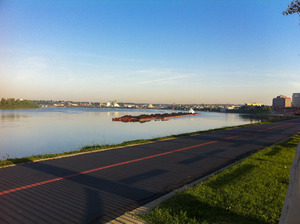
Evansville has great access to different types of transportation. This helps its role in the global economy. The city has roads, trains, water transport, and air travel. The Evansville Regional Airport offers many flights each day.
The city has a growing interstate highway system. I-64 is just north of the city. It connects to St. Louis and Louisville. I-69 now goes all the way to Indianapolis. It provides a direct route to downtown Evansville. Soon, I-69 will also connect to Kentucky and Tennessee.
U.S. Highway 41 connects Evansville to Henderson in the south. To the north, it links to cities like Princeton and Terre Haute. Other important local roads include State Road 57 and State Road 62.
The Metropolitan Evansville Transit System (METS) provides bus service throughout the city. Evansville also has many trails for bikes and walkers. There are also bike paths on some roads.
Evansville has always been important for train traffic. Today, four major freight railroads serve the city. These include CSX and Norfolk Southern Railway. The Howell Yard in Evansville sorts trains and handles cargo containers.
The city's port facilities on the Ohio River are busy year-round. Barges use the river to connect Evansville to other markets. This includes the Great Lakes and international markets through New Orleans. Evansville has been a U.S. Customs port of entry for over 125 years. This means international cargo can clear customs right here.
City Utilities
Electricity and natural gas are provided by CenterPoint Energy. The Evansville Water & Sewer Utility provides water and sewer services. Most of the city's drinking water comes from the Ohio River. The water is treated at a large plant.
Police Department
The Evansville Police Department was founded in 1863. Before that, law enforcement was handled by the county sheriff and city marshal.
Famous People from Evansville
Many notable people have come from Evansville. You can find a list of them in the main article.
Sister Cities
Evansville has three sister cities. These are cities in other countries that have special partnerships with Evansville.
 Osnabrück, Lower Saxony, Germany
Osnabrück, Lower Saxony, Germany Tizimín, Yucatán, Mexico
Tizimín, Yucatán, Mexico Tochigi City, Japan
Tochigi City, Japan
See also
 In Spanish: Evansville (Indiana) para niños
In Spanish: Evansville (Indiana) para niños


